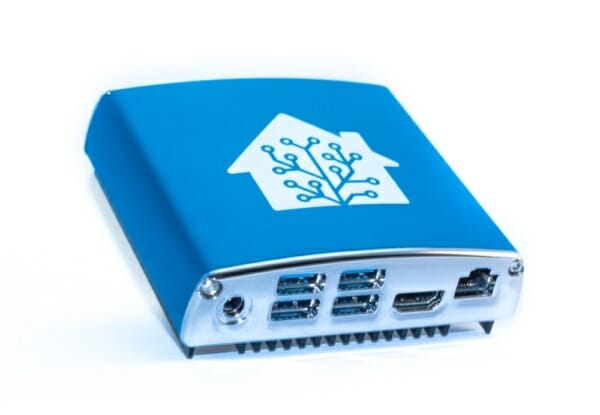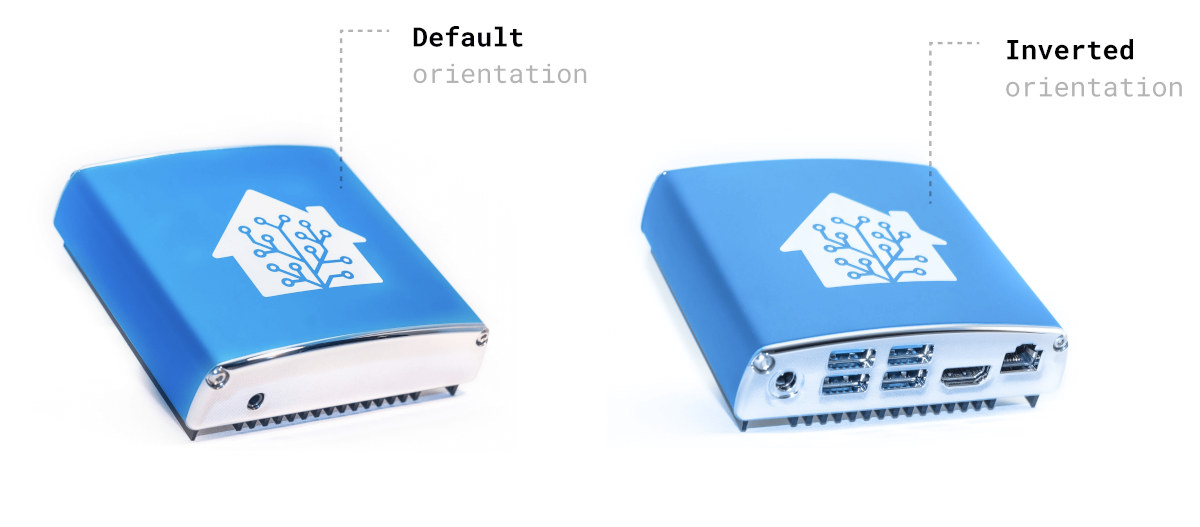 Home Assistant has announced “Home Assistant Blue” hardware with an enclosure designed by Hahn Werke housing Hardkernel ODROID-N2+ SBC, and software supported by BayLibre who helped upstreaming the code.
Home Assistant has announced “Home Assistant Blue” hardware with an enclosure designed by Hahn Werke housing Hardkernel ODROID-N2+ SBC, and software supported by BayLibre who helped upstreaming the code.
The goal is to make Home Assistant Blue a fully open-source platform with long-life support. The device was officially announced during the Home Assistant Conference 2020 held a couple of days ago.
Home Assistant Blue home automation gateway uses the 4GB DDR4 version of the Amlogic S922X SBC, ships with a 128GB eMMC flash module, and offers Gigabit Ethernet and four USB 3.0 ports.
As I understand it, the gateway will run the latest Home Assistant Core 2020.12 that was announced at the conference with a new feature called Blueprints defined as “pre-created automation with user-settable options”, as well as new neural voices for Nabu Casa Cloud TTS (Text-to-Speech), the ability to temporarily disable devices, and more. The release was initially thought to be named Home Assistant 1.0.0, as the beta version was called that way, but the developers changed to a new year and month based versioning schema instead of the semantic versioning used previously.
 Back to Home Assistant Blue home automation gateway. As you can see in the photo the top cover can be oriented as you please to either expose the AV jack (ZEN mode – default) on the bottom, or all other ports with an inverted orientation (DEV mode) that may be more convenient to developers.
Back to Home Assistant Blue home automation gateway. As you can see in the photo the top cover can be oriented as you please to either expose the AV jack (ZEN mode – default) on the bottom, or all other ports with an inverted orientation (DEV mode) that may be more convenient to developers.
The device comes with a power supply and will be plug-n-play with Home Assistant pre-installed. Note the hardware is not equipped with any wireless module, but you’d be able to add Bluetooth, WiFi, Zigbee and/or Z-Wave through the USB ports. If you already own ODROID-N2+, you can obviously install the latest version of Home Assistant, and the developers confirmed Raspberry Pi will still be supported no change there.
Home Assistant Blue is sold for $140, but if you’d like to buy one right now, it will be a challenge as all available units were quickly snapped up, and Hardkernel is out of stock. Ameridroid appears to be out of stock too but is still taking pre-orders with shipping likely to occur next year. Remember you can always use CNXSUPP6 promo code to get $6 on orders over $100. People based in Europe may prefer to purchase the gateway from Webhallen. More information may be found on the official product page.
Thanks to Andreas for the tip

Jean-Luc started CNX Software in 2010 as a part-time endeavor, before quitting his job as a software engineering manager, and starting to write daily news, and reviews full time later in 2011.
Support CNX Software! Donate via cryptocurrencies, become a Patron on Patreon, or purchase goods on Amazon or Aliexpress





I have no idea what this device does.
Sorry, maybe I wrongly assumed most people reading this blog would have heard about Home Assistant.
It’s an open-source software for home automation. You can connect all your Smart Home devices to it, and access/control them in a dashboard.
I wrote about it a few times: https://www.cnx-software.com/news/home-assistant/
Here’s a short tutorial and demo with a gas detector: https://www.cnx-software.com/2019/08/26/getting-started-esp8266-anavi-gas-detector-home-assistant/#anavi-gas-detector-and-home-assistant
Can be installed on RPI ?
Sure. It’s just a pip (python) install.
Home Assistant recommended that you install the “Home Assistant OS” image (previously known as “Hassio”) which include management tools and more to get the full embedded appliance experince instead of only installing the “Home Assistant Core”
Why install on a slower non emmc device?
Because it’s cheaper and somebody may already own one that collects dust. Depending on the number of devices and requirements, it may work just as well as the ODROID-N2+.
Fair point, but i think the clue is collecting dust. It has no real use.
+1 though if installing on Raspberry Pi or any other platform it is strongly recommended to move the data partition from SD-card to a faster USB-harddrive.
Home Assistant OS supervisor includes a simple option to move this data partition and thus dedicate the SD-card for boot only.
This is both to get better performance as well as get more stable storage a Home Assistant logging is infamous for corrupting SD-cards after a while.
> Home Assistant logging is infamous for corrupting SD-cards after a while
Well, same will apply to eMMC storage here – just later. Maybe a smart approach would be to try to lower Write Amplification at the application level (inside Home Assistant)?
Phones run from eMMC and I’ve yet to ever have any issue from one.
I also have a lot of Hardkernel eMMC and some have been in use for over 6 years with no issues, they are user replaceable if by some rare occurrence it begins causing problems.
I don’t get your comment. If ‘Home Assistant logging is infamous for corrupting SD-cards after a while’ is true then it applies to every kind of flash storage be it SD cards, SSDs or something in between like quality eMMC.
BTW: I mentioned ‘Write Amplification‘ above for a reason.
My first Xiaomi phone died because of eMMC flash failure.
https://www.cnx-software.com/2018/10/21/xiaomi-mi-a1-slow-emmc-flash-storage/
And the second failed for a suspected eMMC flash failure: https://www.cnx-software.com/2018/12/03/xiaomi-mi-a2-review-firmware-update-antutu/#comment-574649
I did not write many details for the second, but even raw recovery would fail due to write errors.
One of my problems is the flash was almost always full, at least for Mi A2, so it does not help for extending the life of available blocks. I’ve now learned my lessons and bought a phone with a much larger flash. It will save me a lot of time too.
My hass system with eMMC just died recently. Sad thing I can’t swap it like a SSD or microSD 🙁
Thanks for the details, Jean-Luc. I wrongly assumed that “home assistant” was a generic term covering all such devices and didn’t figure it was a product/project name. It’s become common to use confusing terms to name projects (and I won’t blame their authors for this, naming is extremely hard). Other common examples are “What network manager are you using?” and “can you remind me the name of this video LAN client you talked me about?”.
“Limited Edition” and sold out already so wonder if they even will restock at all with that custom case?
Should also be noted that the ODROID-N2+ will only be their a long-term reference hardware, so it will not be the only hardware platform that they will support.
You also do not need to use their rebranded version of the ODROID-N2+ if you still want that specific long-term reference hardware as you can just get the standard ODROID-N2+ if you do not care about that custom enclosure.
Home Assistant said that they will still be supported many other single-board computers, x86-86 computers, as well as a virtualization hypervisor. Including Raspberry Pi 3, Raspberry Pi 4, a few other ODROID SBC models, and the Intel NUC series (which is currently recommended as the most powerful SBC that they test with).
Home Assistant has also released the design of that ODROID-N2+ case as a 3D printable object which is free to download and 3D print if you have a 3D-printer.
By the way, I think that those new Blueprints are better described as “user sharable automation” as their main point is to make them easy to share with others.
Home Automation Conference video contained a video on how to use a Blueprint that someone else has made.
Here is however also a video on how to make your own Blueprint which you can then share with others:
https://www.youtube.com/watch?v=Bj6zRK2i55E&ab_channel=SmartHomeMakers
Wrt fully open-source platform
Does that include DRAM init and dvfs blobs? So no more potential for cheating on AML??!!!??
There is more information on BayLibre website about Amlogic mainlining contribute progress.
https://baylibre.com/blog/
Exampel:
https://baylibre.com/improved-amlogic-support-mainline-linux/
BayLibre has already been working on that effort for years, the only change is that Nabu Casa (Home Assistant associated company) and Hardkernel is now also in partnership to pay BayLibre development effort to mainline ODROID N2+ support as well.
This is what BayLibre developers do for a living.
Thanks!
So basically nothing new, as the blog is very silent, the latest somewhat relevant entey is kernel 5.4 contributions…
I think that no built-in Zigbee and/or Zwave radio is a big miss here.
Also, does it wall-mount?
Other than rasing cost for those who do not want Zigbee and Z-Wave there are actually several reasons for not wanting “built-in Zigbee and/or Z-Wave radios”.
Firstly, you preferably want external antennas for Zigbee and Z-Wave radios as having internal antennas for radios inside a metal enclosure will give you poor reception. Even if you use USB adapters with Zigbee and Z-Wave radios it is recommended to use USB extension cables to get the radios away from any possible source of signal interference.
Secondly, not only does Z-Wave use different radio frequency ranges in different regions so that you can not use the same physical radio chips in all countries, but both Zigbee and Z-Wave also go through generations of hardware and technology, both to get faster and more powerful chips (to allow more devices and better signal reception) and next generation of Z-Wave (Z-Wave Plus V2 / 700 series / Gen7) and Zigbee stacks.
“Home Assistant Bue is sold for $140” -> Blue
You might want to think about a “What is Home Assistant?” kinda post. I’ve read a bunch of articles you’ve posted about this, and until this one, I totally thought it was some Google Assistant feature that I didn’t care about. I bet I’m not the only one who would appreciate you giving us all an overview of it.
I agree. Unfortunately “Home Assistant” is a very generic choice of name.
Better buy an Intel NUC7CJYH